Sports don’t build character, they reveal it.
- John Wooden
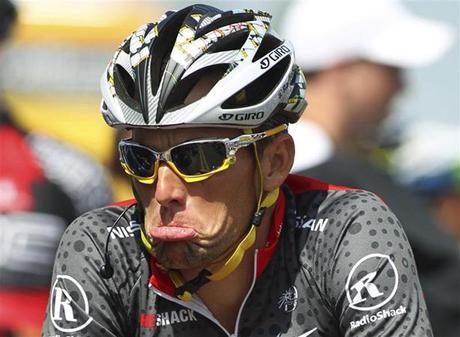
(Image courtesy of www.reuters.com)
Lance Armstrong is arguably the greatest endurance athlete who’s ever lived.
Last week the United States Anti-Doping Agency (USADA) unilaterally declared Armstrong, the 7-time Tour de France winner, guilty of using performance-enhancing drugs during his professional cycling career. As a result, USADA issued Armstrong a lifetime ban from any sport that follows the World Anti-Doping Code, and officially stripped him of his seven Tour de France titles.
We each have our personal machines to rage against, and I guess this one is mine (you might say it makes me want to… heave). But why? In the interest of full disclosure: Lance is a fellow Texan, having been born and grown up in my hometown just north of Dallas… we attended rival high schools on opposite sides of the city at the same time, though to my knowledge we’ve never met. Like everyone else, and perhaps with some deeper sense of understanding thanks to my PhD in Cancer Biology, I admire and respect everything he’s accomplished – from beating stage III testicular cancer, to winning an Olympic bronze medal (2000) and seven Tour titles (1999-2005), to tirelessly growing his Foundation into one of the nation’s leading non-profits in the fight against cancer.
And given such a chock-a-block trophy case, what runner can’t appreciate/sympathize with his admission that his sub-3 hour New York City Marathon in 2006 “was without a doubt the hardest physical thing I have ever done”?
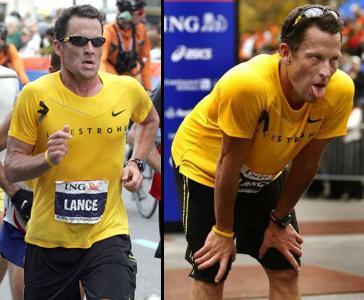
Armstrong running in (left) and getting finished by (right) the 2006 NYC Marathon (images courtesy of www.celebrity-sunglasses-finder.com and www.cyclismas.com)
So do these factors play into my disdain for USADA and its official censure of Armstrong’s career? Maybe… but my disdain goes beyond considerations of Armstrong’s lineage or individual accomplishments. Because more important than the cyclist, what’s been blatantly violated is a fundamental ideology that’s done civilization proud for centuries:
The scientific method. A major reason we’re not all still living in caves and eating dirt.
I’m a scientist, not a lawyer. So rather than argue against USADA’s competence using esoteric legal terms in a dead language, I’ll argue for the basic steps of the scientific method that we all learned in elementary school. I can only assume USADA CEO Travis Tygart was confined to the corner eating paste on the day these were taught:
1) Ask a question
2) Formulate a hypothesis
3) Test your hypothesis
4) Analyze, interpret and report your results
5) Refine your hypothesis accordingly
USADA asked its question, namely “How did Lance Armstrong overcome stage-three cancer to become arguably the most successful and decorated cyclist in history?” It then formulated the hypothesis that Armstrong’s accomplishments resulted from his use of performance-enhancing drugs, including steroids and the red blood cell-inducing protein erythropoietin (EPO). USADA and its partner anti-doping agencies even tested their hypothesis in a seemingly rigorous scientific manner by administering (literally) hundreds of random blood and urine tests over the course of Armstrong’s professional career.
So far, so good…
But here, where USADA is obliged to analyze, interpret and report its results, is where the anti-doping agency’s credibility begins to crumble like a bike seat made of Saltines. Because of those hundreds of tests he took for illegal substances over the course of his cycling career, Armstrong failed… none of them. Not one. Ever. Zeros across the board.
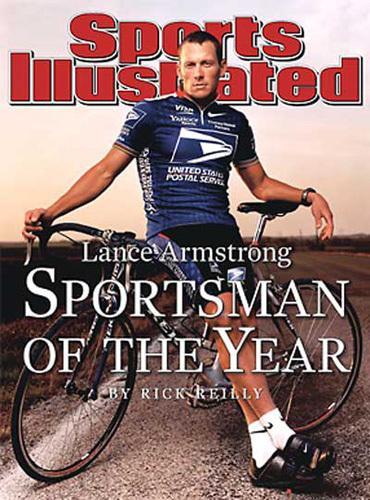
True, there have been occasional reports of a positive test, though such reports were never substantiated. After a positive corticosteroid test at the 1999 Tour de France, Armstrong’s doctor told officials that the drug had been prescribed for topical treatment of saddle sores. And the New York Times recently reported that USADA’s evidence includes “blood profiles from 2009 and 2010 that were consistent with doping,” a finding which apparently led the head of one anti-doping lab to declare “This is not an adverse finding, but this is certainly a sufficient equivalent to testing positive.”
Granted I’ve never been a professional athlete, but I would tend to think that from the athlete’s point of view, testing positive might be considered an “adverse finding”.
USADA, however, refuses to act responsibly and conclude, based on hundreds of agency-sanctioned negative drug tests, that they lack the scientific evidence to support their contention that Armstrong used performance-enhancing drugs. No, with their hypothesis discredited, the frustrated higher-ups at USADA have chosen… to ignore all the silly bothersome data that refute their claims. Instead, they apparently subscribe to the theory, cynically voiced by one local sportscaster here in the Bay Area last week, that “The only thing a negative test shows is that you can mask.” (We’ve had some issues with pro athletes and steroids around here in the past couple of weeks…)
So with little apparent regard for its own credibility, USADA tried to shift the burden of proof on to Armstrong himself, by relying on a far less powerful, less ethical, and less lawful ally: hearsay. USADA’s case against Armstrong now rests heavily, if not entirely, on oft-contradicated testimony from Armstrong’s former, less talented teammates. These teammates include Floyd Landis, who had his own 2006 Tour de France title stripped after he failed a drug test during the race, and who was recently convicted of defrauding his supporters; Tyler Hamilton, who failed multiple drug tests during his own career and who just happens to have a well-timed autobiography scheduled for release next month; and George Hincapie, who reportedly admitted to doping in his 2011 testimony to a federal grand jury.
Based on what USADA has shared with the public, questionable testimonies such as these constitute the crux of its case against Armstrong. But you don’t need to own the Matlock box set to understand that guilt by association proves nothing, particularly when those associates are acknowledged dopers with – in some cases – a clear conflict of interest (e.g. peddling a book). In his statement last week, Armstrong also asserted that “USADA has allegedly made deals with other riders that circumvent their own rules as long as they said I cheated.”
True or not, the possibility raises more than a reasonable doubt as to the integrity and motives of USADA’s key eyewitnesses.
So rather than refine its hypothesis in the absence of corroborating data, USADA has chosen the time-honored standard of the playground bully: deploy headlock and squeeze until victim cries “uncle” or faints from lack of oxygen.
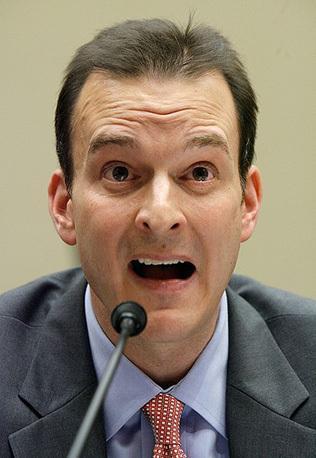
Travis Tygart, USADA CEO and data-despising ty-rant
(image courtesy of www.zimbio.com)
Now even Armstrong, arguably the greatest endurance athlete who’s ever lived, has finally reached his breaking point. Saying “enough is enough,” he has declared that he’s “finished with this nonsense” and will no longer dedicate his time and resources to fight USADA’s charges. Some detractors have seen this as an admission of guilt… after all, isn’t that how Lance became Lance, by overcoming insurmountable odds and outlasting the competition when the stakes were highest?
But for better or worse, the Tour de France and even cancer have something very important in common that USADA’s doping allegations lack… an endgame. Because although Armstrong no doubt has the financial means to continue the battle, USADA has made it clear that its only objective at this point is to find him guilty, and that it intends to make his battle unwinnable by any means necessary. So sure, Armstrong (like USADA) could continue to throw money, resources and life-hours at these allegations in a futile effort to clear his name, but honestly… how, in the face of Tygart’s “Damn the data, full speed ahead!” mentality, will he ever prove his innocence to USADA’s satisfaction? Have you ever tried to prove a negative, say for example that you didn’t eat the last donut hole? Good luck with that.
It’s easy to have a high threshold for someone else’s pain, and that’s the case here with those who see Armstrong’s turn-the-page mindset as slam-dunk evidence of his guilt. I’ve heard members of the sporting media declare with fire and brimstone how THEY would defend their honor to the bitter end if THEY were ever falsely accused of such vile wrongdoing. And they’d probably be right the first, second, third or maybe even the tenth time they were confronted with the same unsupported allegations. But eventually, as the process evolved into (as Armstrong’s lawyer described it) “an endless game of whack-a-mole,” one that farcically shifted the burden of proof on to the shoulders of the accused, well… be honest now… what would you do? Take your bike and go home, maybe?
And the fallout from USADA’s denunciation of Armstrong’s career? Unsolicited donations to his Foundation were up nearly 25-fold (from $3,200 to $78,000) the day after USADA’s announcement, while the number of individual donors was up 9-fold. And according to ESPN.com Sports Business reporter Darren Rovell, Armstrong’s corporate sponsors – including Nike, Oakley and FRS – have responded by reaffirming their support for both Armstrong and his foundation. So clearly, both the general public and some pretty powerful sports brands with a lot at stake have serious misgivings about USADA’s tactics and conclusions.
Any legitimate scientist who chose to navigate the treacherous waters of loose standards mapped out by USADA would be set adrift in his chosen field. And given that USADA is largely funded by a federal grant, it too should be held accountable for its deliberate misappropriation of tax dollars and resources. Even the U.S Attorney’s Office, led by Jeff Novitzky, recently dropped all charges against Armstrong for lack of evidence. Novitzky is the steroid-centric FDA agent who has shown a stubborn if inept willingness to misappropriate federal funds in the name of his own brand of nebulous anti-doping justice.
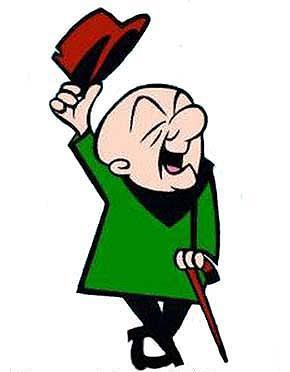
I nominate, as the next CEO of USADA…
(image courtesy of www.crazyabouttv.com)
“Science can’t decide everything,” according to David Howman, director general of the World Anti-Doping Agency (WADA). But Howman is wrong. His uninformed statement might be more accurately expressed as “Our science can’t decide everything.” If the scientific tools available to athletes for masking a positive drug test happen to be more advanced than the tests used by the world’s foremost anti-doping agencies… well then, what does that say about the value of those agencies as watchdogs of integrity, anyway?
Small wonder, then, that its failure to discredit Armstrong has clearly left USADA as a frustrated and defeated agency. But its frustration shouldn’t have been allowed to escalate into full-scale harassment. In any case, it’s not even clear that USADA has the jurisdiction to bring charges against Armstrong, much less strip him of his Tour de France titles.
I’m not naïve, nor am I in denial; I acknowledge that Armstrong may very well have taken performance-enhancing drugs during his career. I’m also not a Lance apologist; unlike the many people whose lives have been positively impacted by the tremendous works of his Foundation, I have no reason to invest my hope and faith in Armstrong as a personal savior. Heck, I don’t even blame him for the fact that the 2011 LIVESTRONG Austin Half Marathon featured the most shoddily crafted race t-shirt I’ve ever received (thanks, Nike).
No, the only dog I have in this fight is the overwrought poodle named science that USADA has nonchalantly tossed into its ring of frustrated and ravenous pit bulls.
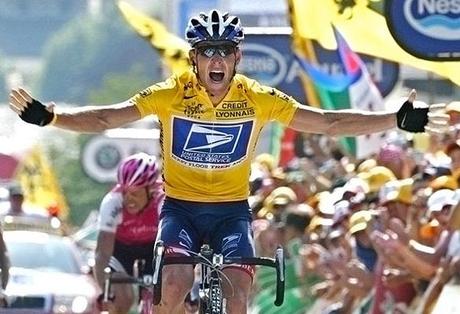
(Image courtesy of www.washingtonpost.com)
Armstrong has characterized USADA’s cranky-poodle-on-the-pantleg mentality as an “unconstitutional witch hunt.” He’s not far off. And in a time of unsettling intellectual laziness, when many Americans equate “truth” with their own personal belief system (creationism? intelligent design? “legitimate” rape?), this sets a dangerous precedent. Hey, if our federally funded agencies are shamelessly willing to play outside the lines and run roughshod over the rules of engagement, well then why should we be expected to do any different?
In his arrogant refusal to abide by the principles set forth by cycling’s governing bodies (including his own), Travis Tygart has made himself and his agency the center of attention in this sordid saga. USADA’s self-appointed stance as judge, jury and executioner even led U.S. District Judge Sam Sparks to write that “USADA’s conduct raises serious questions about whether its real interest in charging Armstrong is to combat doping, or if it is acting according to less noble motives.” Sparks also warned that “The deficiency of USADA’s charging document is of serious constitutional concern”.
So then based on the taxpayer dollars, federal resources, man-hours, and professional credibility he’s wasted for himself, his agency and the sport of cycling… based on all that he’s willfully squandered in his ego-driven pursuit of Lance Armstrong, if I could ask Travis Tygart one question it would be this:
Who’s the real cheater here?
